車の収納スペースを増やしたいので、海外のオークションサイトEbay.comで50年代のスーツケースを買いました。「50s case」または「50s trunk」で探せば、いっぱい出てきます。
アメリカでは本物の50年代ケース(アンティークか?)をまだまだ簡単に手に入ります。買った「Samsonite社」ケースはたった3000円でしたが、もちろん送料もありますね。5000円ほどの送料だったけど、ケースの中はほぼほぼ新品のようになっています。
My car has a tiny amount of storage space, so I decided to invest in a rear luggage rack and a suitcase that fitted the look and style of the car. The car's a replica of a 1957 Porsche Speedster 356, but thankfully isn't worth the hundreds of thousands of dollars the real ones are these days - so I can drive it normally, at least! It's actually built on a chassis from about 1968, I think.
I found this period 1950s Samsonite suitcase on Ebay in America, for about $30, plus about $50 for shipping. The condition is perfect inside, as good as new. The outside was a little scuffed and marked, but after some careful clean up (but not too much!) I was left with a really nice aged patina.
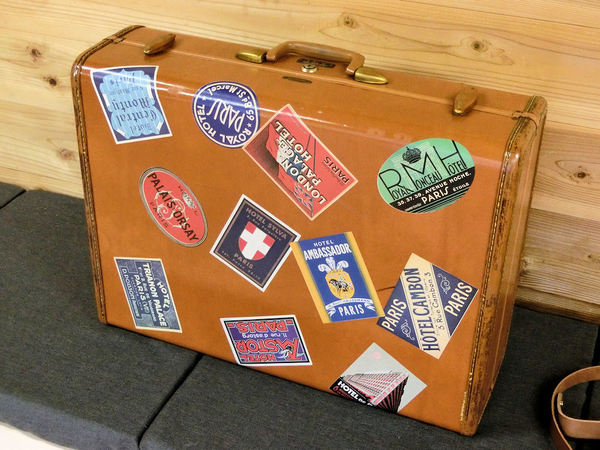
▲ 見た目は確かにきれいでしたが、その上にステッカーも張りました。「LaughingElephant」のメーカーからヴィンテージステッカー20枚セットを買いました(2000円): https://laughingelephant.com/stickers/
テーマはヨーロッパのホテルだったので、ケースと車に合うと思った。
Although the case is immediately recognisable as an antique, I wanted to add travel stickers to it, so give it a great look to match the car. I found this set of 20 reproduction stickers from Laughing Elephant, themed around European hotels of yesteryear.

▲ 可愛いでしょう!ラックに載せたら完璧!
A perfect match for the car... and I doubled my storage space!

▲ ステッカの上に透明のツヤありペイントをスプレーしましたが、100%防水じゃないから天気を見ないといけないですね。
I added several layers of spray-on clear varnish, to try and waterproof the stickers and leather as much as possible. Even so, it's not 100% waterproof, so I have to watch the weather carefully!

▲ 長い旅にはちょうどいいですね!
Just right for a long drive on a sunny day!
2階のほうは暮らせるスペースになったので、今度は1階の作業が始まります!
The upstairs of the house now looks pretty good, so it's time to move on to the downstairs space....
▲ 買う前に見学したときの様子。スタジオっぽいけど、暗かった。だけど、広い部屋が頭の中に想像できた。
When I originally went to see the house before buying it, this is what the downstairs looked like! With the storm shutters closed and a ton of painting supplies strewn around, it was quite hard to envision what it could look like empty.....

▲ 買った頃の写真です。物を全部外して、雨戸を開くとやっぱり広かったですね!
... but once everything was cleared out, and the storm shutters were open, it looked a whole lot more promising!

▲ 外にある杉松の影が多いので、昼間にも電気つけないとちょっと暗いです。将来的に林をちょっときれいにしますが、その前に部屋の目的を考えよう。。。
There are quite a few giant cedar pine trees surrounding the house, which make it a touch dark even in the daytime, but at some point I'll trim those to brighten things up. Until then, the lights and large windows keep it bright and quite airy.

▲ まずは冬用の暖房要りますね!阿蘇では薪ストーブが多いですので、ヤフーオークションで35,000円で買いました。販売店が熊本市の近くでしたので、相変わらず青い車で取りに行きました!ただし、何と70kgでしたので、車を入れたときに店のフォークリフトを使いました。阿蘇に家に届いたときに息子のゆあんさんの力を借りました!????
The first project I wanted to tackle in this room was some heating, as it required some small structural changes. Aso is quite a rural area, and many of the houses here have wood-burning log stoves. I managed to snag this one on Yahoo Auctions for $350. It's pretty small for a wood stove, but it still weighs 70kg! So when I drove to get it (after removing the passenger seat in my little car!), we had to load it in with a forklift truck! The lift driver did look a bit nervous! ???? Of course when I got back to the Aso house, I had to enlist the help of Euan (my son) to get it out of the car and into the house!

▲ 部屋のコーナーに薪ストーブと煙突を入れますので、不要の勝手口を壁にしました。横にデッキを作るつもりですので、そっちから外に行けます。まだまだ壁の木材を見ると色違いが見えると思いますが、あとから隠せるだと思う。
The stove is going in the corner of the room, so I can maximise the rest of the space, and this meant that I needed to board up the backdoor. Every Japanese house insists on having a narrow back door, for access to.... bins?! No, not really a reason. But since I can use the big glass doors onto the deck on the other side of the room to get outside, this back door was fairly redundant. So I boarded it up, and should be able to disguise the different wood colours later on.

▲ 次はパインの2x4で強い台を作りました。前の勝手口の低い床も隠せた。
Next I knocked together a very sturdy platform for the stove, from cheap 2x4s, which also enabled me to cover the lowered floor by the back door.

▲ その上にコンパネ板と石を置きました。ハンズマンから1平方メートルを買いました。
On top of the platform I placed thick plywood and then about 1 square metre of slate-like stone, bought from my local Handsman DIY shop.

▲ 石を位置を決定してからコンクリートを入れました。
Once I had arranged the stones to my liking, I set them in concrete, and added a few more decorative strips of wood.

▲ 最後にウォルナット色でステインしてから、薪ストーブを載せました。壁に防熱の板をこれから張りますが、とりあえずこれで行きます。
Lastly, I woodstained the platform in a walnut colour, and lifted the stove up on top. Thanks, guys, for helping me out there! I'll be adding heatshielding material to the walls later on, but for now I can call this done.

▲ 煙突の作業もいつかしないといけないんですが、その前にソファとテーブルを塗らないとね。
Of course I will also need to add a pipe chimney at some point too, but first I can move on to painting up these sofas and chairs!
この家のベッドルームは6坪の畳式部屋です。もちろん布団のために大きい収納もありますが、私はベッドのほうが好きですから、その収納スペースをなくして、約7.5坪ほどの部屋に変更しました。夜寒いの阿蘇には暖かい暖房が必要ですが灯油ストーブはめんどくさいですので、今回DIYで床暖房を作りたいと思います!
思ったより安かったで、朝まで安心でポカポカしていきます!
Japanese rooms are traditionally measured in "tsubo" units, which are based on how many tatami mats would cover the floor. So my bedroom here is a 6-tsubo room, meaning that it would fit 6 tatami mats. And indeed, unlike the rest of the house, it actually has tatami mats for flooring. I've got nothing against tatami floors, but they tend to look scratched and old pretty quickly, especially with a large dog in the house.
So I decided to remove the tatami mats in the bedroom, and replace them with wood flooring. While I was doing that, it seemed a good opportunity to rip out the built in cupboard at one end, and enlarge the bedroom with that space instead. Finally, I wanted to try installing some underfloor heating, so that at least I would have one cosy room with modern technology. If you've never experienced the warmth of underfloor heating, you're really missing out! It's great!

▲ まずは電気床暖房用の「ヒーティングフィルム」が必要です。Ebayで「heating film」を探せばいっぱい出てきますが、買ったフィルムは韓国のFELIX社の「EXCEL305」でした。幅50センチで来ますので、7.5坪の部屋には20mを注文しました。20mでたった12,000円でしたが送料は追加の1万円かかりました。
Fitting you own electric underfloor heating system is actually not that complicated, as long as you do your homework properly! Happily, I'll write it all down for you, to save you some effort!
The first thing you'll need is electric heating film. This is normally sold in 50cm-wide rolls, as shown in the photo. There are loads of brands on Ebay, and after some checking I went with this "Excel305" by the Korean firm FELIX. With my enlargened room now measuring approximately 2.5m x 4m of floorspace, I ordered 20m of heating film for $108. It was a little heavy, so shipping was a further $117.

▲ 床暖房にはコントローラーも要りますね。この商品はたった1900円(送料込)で買いました。「110v floor heating controller」で検索するといっぱい出てきます。この商品は100v~240vまで接続できますので、安心しました。自動センサーも付いてきますので、ご希望の温度に設定すると自動的にキープできます。
部屋の大きさによって3600ワットの制限はありますが、簡単に計算できます。ヒーティングフィルムの機能を調べると50cm幅で各100cmには110ワットを使うそうです。ということは1平方メートルには220ワットを使います。コントローラー機械は3600ワットまでですので、1個には16平方メートルのフィルムをつなぐことができます。それは約4mx4mの広い床ですね。
The second bit of tech you'll need for this project is a thermostat controller. If you search for "110v floor heating controller" on Ebay you'll find tons. The one I bought (pictured) cost only $18, shipping included! This one can handle mains voltage anywhere from 100V to 240V, so is fine for Japan. It has scheduling functions, and two temperature sensors, so you can set it to heat to 20 degrees, for example, and it will keep it there all night.
There's a little bit of maths you'll need to do, to check the maximum wattage isn't exceeded. A single controller can supply up top 3600 watts of power to your heating system, so you'll need to check the per-metre wattage of your heating film. The film I bought uses 110W for every 1 metre of 50cm-wide film, so for one square metre of film it will require 220W. So working backwards, you can calculate that one 3600W controller can work with approximately 16m² of heating film - which gives you a maximum area of 4mx4m for one controller.

▲ ほかの必要な商品は電気ケーブルとこのフィルム用のクリップです。これもEbayで822円で40個を買ったです。「heating film clamp connector」を探せば出ます。
You'll also need some clamp connectors for the heating film, and plenty of electrical cable. I bought this pack of 40 clamp connectors for about $8 from Ebay.

▲ 作業を始めましょう!まずは古い畳を外しました。その下には1枚の薄いコンパネ板しかなかったので、断熱材を入れないといけないですね!
Time to get to work! First thing to do was to remove all the old tatami mats. Having removed them, I found that the "underfloor" was a laughably thin single sheet of plywood, so I guess I'll need to add some extra insulation!

▲ 断熱材板は特に必要ないですが、お勧めです。30mm厚みのフォームを入れました。
Thankfully tatami mats are quite thick (about 5cm), so removing them left enough room for 30mm of insulation foam sheets, plus the wooden floor I planned to add on top.

▲ その上にヒーティングフィルムを置きます。各50センチのフィルムには2個のクランプつなぎでケーブルに接続します。+とーを間違いないように赤と黒のケーブルを使いました。クランプをブチルテープで囲みました。
Then you simply unroll the heating film on top, in strips of 50cm width. The strips will each need 2 clamp connectors at one end (the wall end), to connect to the positive and negative sides of each film. I used red and black cables for the wiring, and covered each clamp connector with waterproof butyl tape.

▲ 各フィルムからコントローラー機械までケーブルを通さないといけないので、壁の横に1センチほどのケーブル用にスペースを掘りました。そして、壁の中に入れます。そこで5本の赤いケーブル(+線)を配線コネクターで一本にまとめました。黒いケーブル(ー線)も同じ風にまとめました。最後に赤い線と黒い線をコントローラーに差し込んで、電源につなぎます。私が近くのコンセントから電源につなぎました。
テスト起動は成功したら完成です。
Each strip of film needs to be connected via cables to the thermostat controller, which I mounted in the wall near the door. The insulation foam made this an easy job, by just cutting a 1cm wide channel in the foam for the cables alongside the walls. The 5 red cables and 5 black cables then went inside the wall, and were joined using simple cable connectors into a single red and single black cable. These two cables are then inserted into the controller unit, and the mains power is connected. I ran an extension from a nearby power socket for the main power.
Then it's time to test fire your new heating system. If it works as it should, then you're ready to cover over the heating film strips and wrap up!

▲ その上にフローリングを置けます。畳にも使えそうですが、この新しいベッドルームにはフローリングにしたかったです。
写真の左側にコントローラーがあります。コンセント2個も入れました。
ライトはもちろんイケアから買いました!
I chose a light coloured wood flooring for the bedroom, but you can apparently use tatami mats instead if you prefer.
On the left-hand wall you can see the two power sockets close to the floor, and the square thermostat controller unit above that near the door. The new ceiling light is from Ikea - no surprise there!

▲ 2x4パインで簡単なベッドフレームを作りました。とりあえずこれで行こうかなぁ。。。
犬のケイティちゃんも新しい3万円の床暖房には大満足ですね!
I knocked together a cheap and cheerful bedframe from 2x4s, which will do for now, I think.
For a $300 heating system, this was a project well worth doing - Katie the dog certainly likes it!

▲ ちょっと古いスタイルですが、それは好みですね。
The interior maybe a little traditional, but I like old stuff!

▲ この大きいたんすもイケアから買いました。外した収納スペースのところに入れました。収納的にちょっと小さくなりましたが、部屋がすごく広く感じがしますね。
On the far wall you can see the space that was opened up by pulling out the built-in storage cupboard. Instead of that floor-to-ceiling cupboard, I switched to a large chest of drawers (again, from Ikea) which gives plenty of storage spce but keeps all that open space above it. The bedroom certainly feels a lot larger!
玄関の窓の入れ替えができましたので、今度は玄関のリフォームをしたいですね。この玄関はものすごい大きいですが、玄関だけで使えばちょっともったいないかなぁ。ということは暖かい「読書スペース」に変更します!
With the new front window in place, I can finally turn to renovating the downstairs. To start with, I decided to build a little reading nook into the oversized entrance hall, since it didn't really serve any purpose. If I later decide to make this a shop or cafe, it could easily be converted to a register/admin space.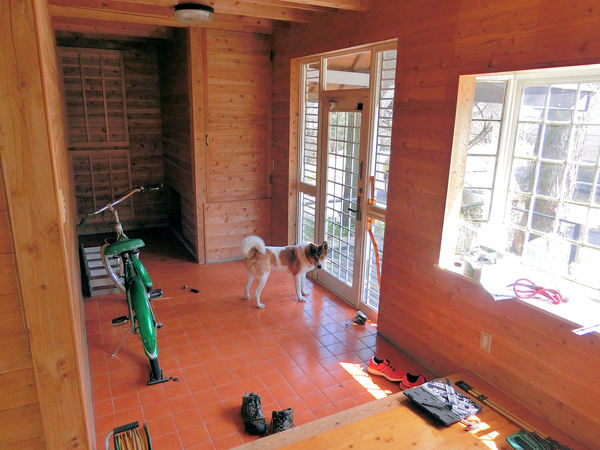
▲ 家を買ったときの状態。ほら、非常に広いでしょう?ドアの左側に壊れていた展示窓の収納スペースですが、その壁を外したら小さい部屋は作れそうです。
So this is how the space looked when I bought the house. As you can see, the genkan (entrance hall) is pretty wide, and since in Japan this space is only really used for removing shoes before entering the house proper, it seemed like a waste. The large cupboard in the far corner is in fact the shop-window display area, that the house previously featured. That window exploded in the earthquake in 2016, and I've no desire to keep that area there - instead, knocking out the cupboard walls would let in tons of light.
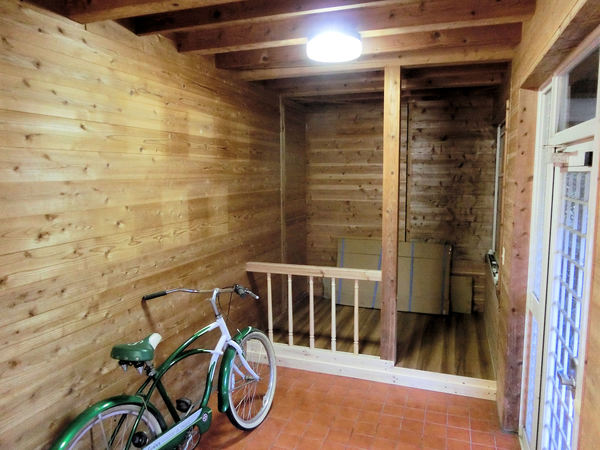
▲ 真ん中の柱だけをそのまま残した。タイル床の上に2x4とフローリングで新しい床を置きました。そして、柱の左側に手すりを作りました。ハンズマンDIY店からテーブルの脚5本買って、そのまま使いました。
With the cupboard walls removed, the only part I needed to leave in place was this central pillar. So I decided to build a simple railing to the left of it (using table legs from my local DIY store), and have the entrance to a raised area on the right. The new floor was a simple build from 2x4s and some cheap wood flooring.

▲ 手すりを色ステインして、やっと家具が入れる状態になりました。アームチェア(STRANDMON, 24,990円)とライト(OTTAVA, 5,499円)はイケアから買いました。
After the railing had been stained to roughly match the surrounding wood, it was time to add an armchair and a retro-industrial decorative light. Running a new power cable to the middle of the ceiling required removing some of the wall planks to find the connections, but it was so worth it.
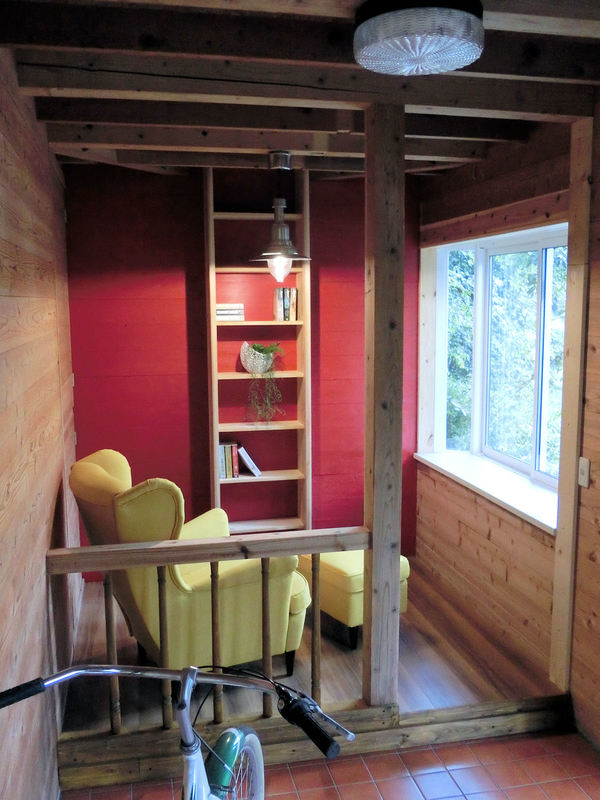
▲ 最後に壁を茜色にペイントしてから、床から天井までのシンプルな本棚を作りました。新しい窓を入れたら完成でした。このアームチェアを入れるとちょっと狭くなったけど、一人の読書スペースには最適です。窓から阿蘇さんも見えますので、大満足!
Here's the finished "book nook"! I painted the far wall a vibrant 'madder' red (it's a root used in dyeing, apparently), and contrasted that with a floor-to-ceiling bookcase in natural wood. A pretty simple job, but look at the difference!!
With the new window in place, it's a cosy and bright space for one person to relax and read in the daytime, with a view of the woods and the Aso volcano out of the window. I love it!
▲ キッチンとバスルームがやっとリフォームできました。ということは暮らせる家になりましたので、次の作業は地震から受けたダメージの修理ですね。あっちこっちにサイディングの小さいひびなどもありますが、やっぱり正面の窓から始めたいです。
2016年まで染め教室のアトリエでしたが、地震の時に玄関横にある展示窓が爆発したそうです!それからの3年間、窓なしでビニールシートで隠していただけです。嵐の時に強い風と雨がよく入ってきました。2019年家を買ったときに結構悲しい状態でした。
With the bathroom and kitchen both finished, the house was finally liveable, so it was time to move on to the exterior of the house - it was time to fix the 2016 earthquake damage! There's quite a bit of cosmetic damage to the exterior (cracks and broken siding etc), but I think we'll start with the biggest problem....
Until the 2016 quake this house had been a dyeing workshop, and had had a large shop display window at the front. Presumably to display dyed clothes and other products. But the big quake had shattered that window completely, and it was hurriedly patched with a plastic sheet for the next 3 years. Sadly, occasional spring storms had let in some wind and rain, so it was in a pretty sad state when I bought the house in 2019.

▲ まずはひどい天気から家を守りたかったので、シートを取って、仮に板を入れました。
So one of the first things to do after buying the house was to remove the old plastic sheet cover and patch it with some spare wooden boards.

▲ 板の外側にまたシートを張りました。とりあえずこれで行こう!
After some new plastic sheet was wrapped around, it was at least waterproof for a while.
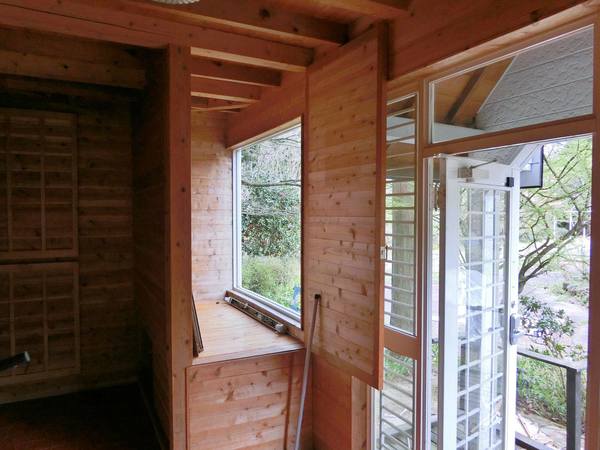
▲ 一年たちましたがやっとエクステリアの修理が始まりました。板を外した時に玄関からの景色がよかったです。阿蘇さんも見えますし、そこに新しい窓を入れ替えます!
Jumping one year forward, and it's finally time to deal with the house's exterior. With the temporary boards removed, the view was actually pretty good, with a fine view of the Aso volcano. So I hatched some big plans to knock out the internal walls of that display cupboard area and put in a large picture window.
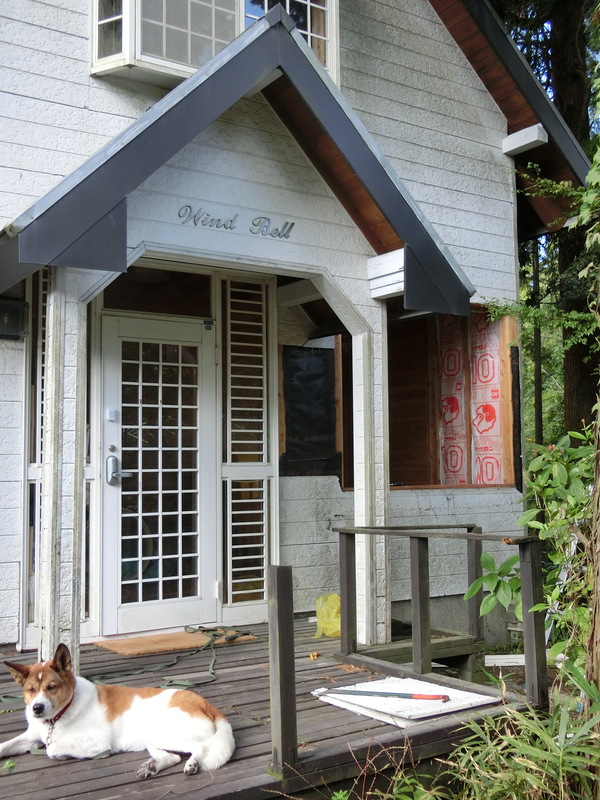
▲ 古い展示窓のサッシを外すには、周りのサイディングも外さないとね。めんどくさいけどしないといけない作業でした。
After carefully pulling out the old aluminium window frame, I also had to carefully remove several of the surrounding siding boards. If you don't do that, then it's impossible to waterproof the new window frame!

▲ ここまでサイディングを外しました。いいチャンスだったので、新しい断熱材も入れました。
So while I was pulling off the old exterior boards, I also took the opportunity to fit some new glass-fibre insulation.

▲ この家の窓サッシが面白い形ですけれども、結構高い種類です。80年代の窓サッシにはペアガラスはなかったそうですが、今回ペアガラスしかないみたいです。確かに高いタイプです!サイズはちょっと大きくして、楽天の店から17万円で買うしかなかった。
悲しい買い物ですね!キッチンと大体同じ価格ですが、今回は修理だけです!????
2~3時間ぐらいで自分で組み立てましたが、やはりこんな大きさと重さで一人で運べなかった。近所のShujiさんと一緒にフレームに持ち上げました。Shujiさん、ありがとうございました!助かりました。
Right, onto the new window! The windows of this house jut out about 30cm from the walls, which is quite a pretty window design. Unfortunately it's also a very expensive shape of window, especially since they only make double-glazed versions these days! So this window was ordered from a Rakuten online store for about $1700! That's almost as much as the entire kitchen rebuild cost, but just for a repair job! Oh dear.
It was a fairly easy process to put together the various parts of the window frame kit, just following the paper instructions. It took maybe 3 hours, but then I had to recruit the help of my neighbour Shuji to help me lift the whole thing into the empty window socket. Thanks, Shuji!

▲ 新しい窓サッシを入れた日の写真です。新しい防水シートとテープで天気から守ります。後はサイディングですね!
2016年からずっと悲しい正面でしたが、やっと家の笑顔が戻せました!
So here's the new super-shiny window, fitted into the front wall of the house. Waterproofing sheets and tape will keep it watertight, and then the only thing remaining is to fit the old exterior boards into place around it.
After 4 long years of neglect, the house has finally regained it's front face again! What a difference!
〒869-2226 熊本県阿蘇市乙姫2070-48
Aso City, Otohime 2070-48
Open from 13:00~17:00*
Fridays & Saturdays
(* if the door's closed, we might have popped out to walk the dog... back soon!)







Painted models available 塗装済の模型発売中!
Making garage doors ガレージの扉DIY作成
New side-project... a hobbit house! ホビットの家
Shops added to the shop ショップにお店
Repainting a (mini) car ミニカーのリペイント
Buying land in Otohime 乙姫で土地探し
Scale model of the Inaba Residence 稲葉家下屋敷の模型
0 Comments :
Write a comment :